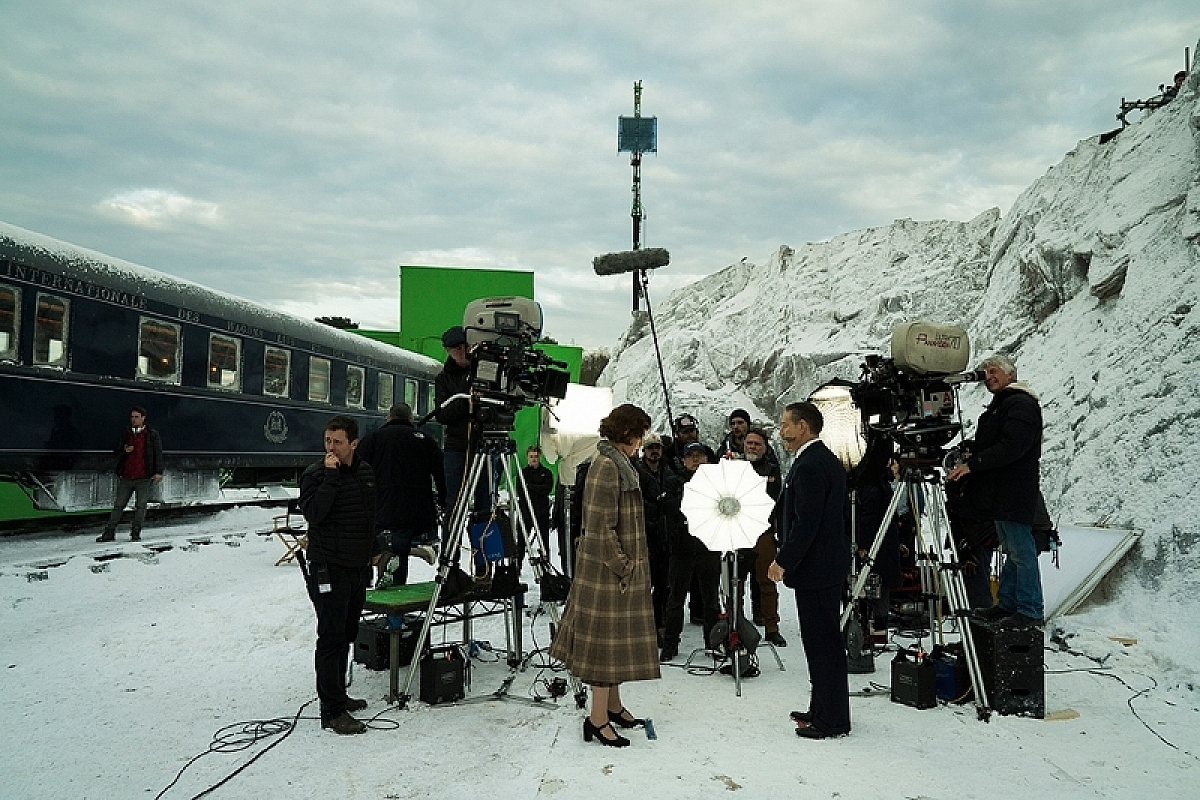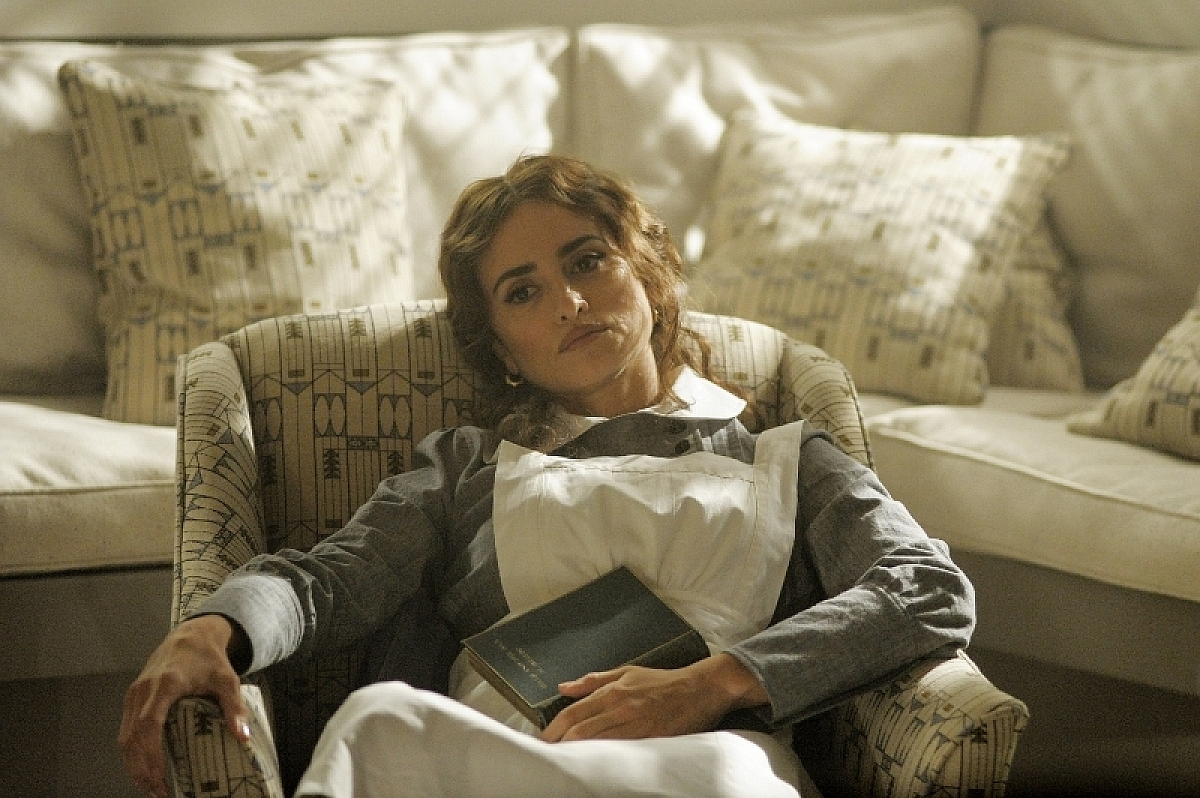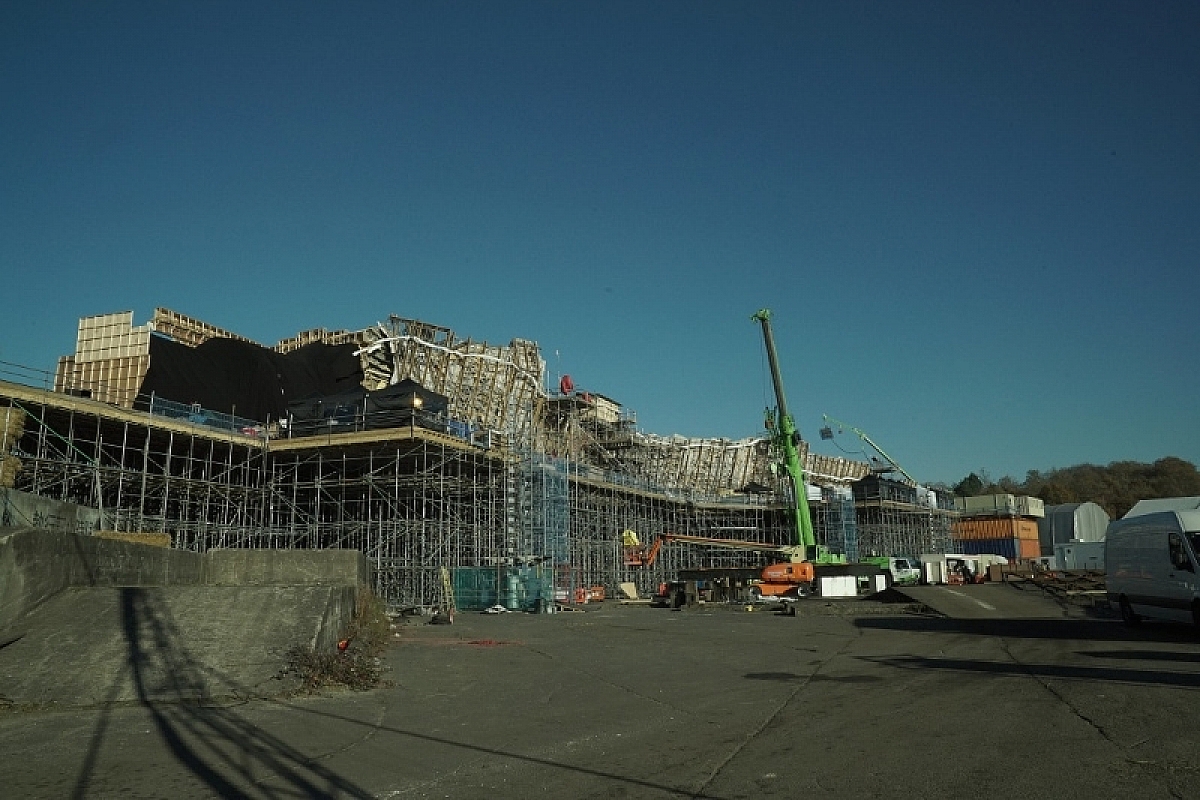Ask a Filmmaker - The Answers: Haris Zambarloukos, BSC GSC discusses 'Murder on the Orient Express'

Haris Zambarloukos, BSC GSC. Photo by Nicole Dove.
The questions are in and the answers are back! A big thank you to cinematographer Haris Zambarloukos, BSC GSC for participating in our Ask A Filmmaker series and for answering your questions on how he shot this murder mystery.
Scenes:
1. When Poirot enters the train station and we're introduced to all the characters...was this one continuous take? Beautiful staging!
Thank you. Yes, it was all one take, shot on our set of Instanbul Station in Longcross Studios, Sir Kenneth had conceived of the shot as a way of just immersing the audience into this great event which is the train departing, we saw all the scenes that included all our cast as event shots, that something special had to happen for the audience.

Getting ready for a take on "Murder on the Orient Express". Photo by Nicole Dove. © 2017 Twentieth Century Fox Film Corp. All rights reserved.
Technically it was achieved by mounting our 65mm Panaflex camera onto a Libra Mount on an electric tracking vehicle. As you have noticed, the real challenge was in the staging. It's so easy to underestimate how hard it is to block a scene like this, mainly because it all seems so effortless but this is a real tribute to Kenneth Branagh's masterful directing, I really don’t know anyone else who can do this. His incredible theatre experience has given him a unique cinema talent in this way, on stage everything is a single shot.

Kenneth Branagh stars in and directs Twentieth Century "Murder on the Orient Express". Photo by Nicole Dove. © 2017 Twentieth Century Fox Film Corp. All Rights Reserved.
2. How did you produce the realistic camera shake while on the train?
We used a process technique for all our interior train travel shots therefore all our trains were stationary. This included using large LED screens supplied by VER to create an enhanced virtual environment on stage outside the train wagon windows. The footage for this journey was shot months in advance in New Zealand on a camera array system that comprised of 7 cameras shooting simultaneously at different angles. The footage was then edited and chosen for particular scenes, then stitched together by the VFX team led by George Murphy. It was then played back live outside the stationary train on our Longcross sound stage.

Daisy Ridley and Kenneth Branagh on the set of Twentieth Century Fox's "Murder on the Orient Express". Photo by Nicole Dove. © 2017 Twentieth Century Fox Film Corp. All rights reserved.
Our train wagons were placed on hydraulicgimbals. Our SFX department led by David Watkins created train movement by programming the three dimensional movement into the hydraulics and setting a pattern based on the footage we projected for each particular scene. The hydraulic movement then naturally agitated the camera and the operators (as it would if the train was moving), we never had to add any further camera shake, even the actors where moved around by the hydraulics and any fluid elements like water in a jug had an organic agitation.
3. There is a great scene in the film where Poirot is contemplating his fears while holding a photograph of his lost love. When he looks out the window, the camera swoops in from above the train and passes the window before going almost under the train. What was the inspiration behind filming so much of the movie with such interesting angles and motions? It was very refreshing to see such a unique take on the content.
All of our motivation was emotional. What is the underlying psychology? What is beneath the surface? The interviews were very static, just simply composed portraits… However, whenever we felt the need to, story wise, we would move out of the train and create swooping crane shots or other dramatic shots that let the audience feel the isolation or immense presence of nature that would permeate a person’s thoughts if they were trapped on a viaduct in a blizzard just after a murder was committed.

Penélope Cruz stars in Twentieth Century Fox’s "Murder on the Orient Express". Photo by Nicole Dove. © 2017 Twentieth Century Fox Film Corp. All rights reserved.
4. What was the decision behind having a bird’s eye as Pirot talks about the murder?
This was a very bold decision by Ken to commit to shooting this scene in this way and this way only. There is no coverage for the scene, that’s it. He was inspired by Hitchcock’s Dial M for Murder, but it was a very functional shot as well. Firstly, it placed the murder victim and Poirot in the same frame for the prolonged time of the scene, the two are literally intertwined from that moment on. It was both graphic and informative at the same time, you saw the clues and understood the crime scene immediately. And ultimately it did away with what would have been a very cutty scene. The minute we went to ground level with the camera we would be forced into a conventional shot - reverse shot set up that would be purely expository.

Johnny Depp stars in Twentieth Century Fox’s "Murder on the Orient Express". Photo by Nicole Dove. © 2017 Twentieth Century Fox Film Corp. All rights reserved.
5. What were the biggest challenges about shooting the night scenes?
Most of our night scenes were on the viaduct, so suspended three stories high. Our logistics problems were how to use lighting cranes efficiently and working out the light levels for our area. Conceptually the challenge is always a matter of balance, how much mood you need, what stays realistic for moonlight, what are the ambient light levels from the train interior, while still illuminating the actors and the environment. I have found over the years that the scene speaks for itself, there is a mood that is required and that is what we base our illumination on.

The viaduct set at Longcross Studios UK on Twentieth Century Fox's "Murder on the Orient Express". Photo by Nicole Dove. © 2017 Twentieth Century Fox Film Corp. All rights reserved.
6. How did you achieve that shot almost at the end of the movie, that resembles The Last Supper - where the 12 suspects sit around the table in the tunnel? It was certainly my favorite shot!
The shot was conceived during prep. One of the fundamental elements of our interpretation of this amazing book was the desire to add elements of tragedy to the story. Tragedy always has real sense of consequence to an action or event. The end always has a form of resolution and catharsis. We wanted Poirot to have a moment of revelation where at his most perilous moment he understands that it must be all of them that committed this murder. It so happens that the suspects are a Biblical number so we immediately looked at Last Supper paintings throughout history and tried to recreate that image somehow in our film. That meant that we had to stage it outside the train, not inside as the book is written. That meant we had to introduce the table in an earlier scene, which we did when the railway workers arrive to re-rail the train. In other words, we set the scene for this very dramatic shot early on in the film. In using such a symbolic shot to set up the denouement scene we knew that the overall tone could then move into a revealing of the crime and its consequence in a tone that was more akin to ancient tragedy, more why they did it than who did it.

Kenneth Branagh and Daisy Ridley star in Twentieth Century Fox’s "Murder on the Orient Express". Photo by Nicole Dove. © 2017 Twentieth Century Fox Film Corp. All rights reserved.
Workflow / Why Film:
1. Was the KODAK VISION3 500T 5219 the only stock used in the film? If yes, why?
We used 5219 for our interior scenes and our exterior night scenes but we also used 5207 and 5203 for day exteriors. My choice for ASA is simple, I generally go with the slowest stock I need for the given light levels bearing in mind that my preferred stop is T4. The B&W footage was all shot on 5219 and turned to B&W inmost as no 65mm B&W stock exists. The newsreel footage was 5219 pushed 1 stop to give it a little more grain.

Kenneth Branagh (r) and cinematographer Haris Zambarloukos on the set of Twentieth Century Fox's "Murder on the Orient Express". Photo by Nicole Dove. © 2017 Twentieth Century Fox Film Corp. All rights reserved.
2. Can you talk about the work flow from capture through dailies to the digital intermediate? Do you record anything digitally on the monitor for on-set review or is that review processed saved for the dailies? How much of the look is captured in camera during the film processing versus added later in the digital intermediate? Did you pull or push during any of the film processing?
I worked in the same way I have worked on 35mm since DIs have been part of our workflow. I do not review on set, there is never any time. Our footage was processed and scanned and we set up a dailies grading facility on site at Longcross. I would spend my lunchtime reviewing the previous day’s work with our dailies colourist Sam Spurgeon and then our crew could review in our digital screening room at 2K at the end of the day. I prefer to keep a good communication going between myself and the colourist rather than some elaborate and often misinformed reference scheme. The edited film was scanned and Fotokem at 8K downrezzed to 4K and then I created the final look at Goldcrest with Rob Pizzey using a digital grading suite ... using all the skills that we have acquired using this very important cinematography tool. From that DI we created our DCPs, digital deliverables, our Dolbyvision etc. and we also made 70mm film outs that we used to create our 70mm prints at Fotokem with Kristen Zimmerman and Andrew Oran. Regarding our use of digital and analogue technologies for the creation of this film, this was not a conflict but a very happy marriage.

Olivia Colman, left, and Judi Dench star in Twentieth Century Fox’s "Murder on the Orient Express". Photo by Nicole Dove. © 2017 Twentieth Century Fox Film Corp. All rights reserved.
3. I would like to know why you chose film over digital for this movie?
It seemed to suit the story and its emphasis on portraiture, the time period, and more importantly the type of experience we wanted the viewers to have. I feel a greater emotional connection to characters portrayed on film and it is also the medium I have used the most and feel most adept with.

Michelle Pfeiffer stars in Twentieth Century Fox’s "Murder on the Orient Express". Photo by Nicole Dove. © 2017 Twentieth Century Fox Film Corp. All rights reserved.
4. Do you think 70 mm is for smaller productions? Or is it slightly elitist?
I believe every filmmaker has to choose for themselves what kind of viewing experience they want to create for the audience and what are the logistics of the production and find the happiest marriage of the two.